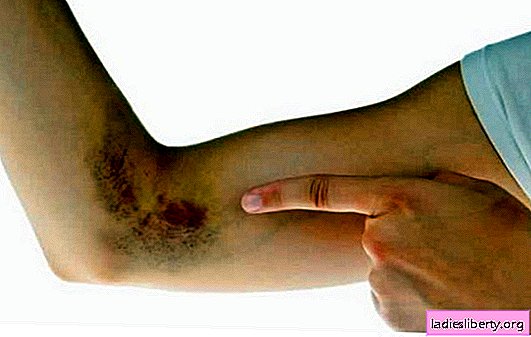
Ticks are small insects that are very dangerous because they often carry some human infections. Even with one tick bite, the victim can become seriously ill and become disabled. Let us consider in more detail what needs to be done if the tick bit a child and how this can be prevented.
The child was bitten by a tick: what to do and what is the danger
Most often ticks carry such diseases:
1. Tick-borne encephalitis is an infection that affects the brain of the victim. Symptoms of it are high body temperature, dizziness, weakness, fever, and others. To protect yourself from the development of this disease, you must enter immunoglobulin as a prophylaxis on the first day after a bite.
Also, no sooner than ten days after the bite, you need to donate blood for analysis in order to examine it for encephalitis.
2. Tick-borne borreliosis is also a very dangerous disease, which is often asymptomatic. When it becomes chronic, then the person becomes disabled.
Tick-borne bolrreliosis is quite common in the territory of the Russian Federation. As a prophylaxis for a tick bite, it is necessary to drink one tablet of doxycycline. This must be done no later than two days after the bite.
3. Hemorrhagic fever is a virus that is accompanied by fever, internal and subcutaneous hemorrhages.
4. Crimean fever is also accompanied by weakness and fever. It can be treated for a long time with the help of antiviral drugs.
What to do if a child is bitten by a tick: first aid
First aid for a tick bite involves the following measures:
1. First you need to identify the tick. To do this, you should carefully examine the body of the child. Most often, the ticks "settle" in the scalp, on the neck, under the arms or knees, that is, in those places where the skin is thinner and the vessels are closer adjacent.
It is not difficult to notice a tick - even if it is small, a tubercle will be clearly felt on the skin. If the tick is large enough, and has already managed to pump blood, then from above on the skin of the child it will be visible (externally, such a tick looks like a round gray bean).
2. If the tick is not strongly sucked, then its body will rise above the skin. Completely, he had not yet managed to get through. In this case, you can try to remove it yourself. However, if the tick completely penetrated under the skin, then you need to see a doctor.
3. To remove the tick from the child, you must carefully grab it with your fingers or tweezers and begin to slowly rotate in a circle, gradually pulling it out. In this case, the entire process can be described as unscrewing the nut.
It is important to know that it is impossible to rush at the same time, since with a sharp capture the head of the tick may remain in the skin of the child, which threatens with infection.
4. Next, remove the tick should be placed in a closed container and put there a little moistened fleece so that he could not die. This is necessary for future research on the tick.
5. The bite site itself should be thoroughly treated with alcohol or iodine. It is also advisable to wash your hands with alcohol in case you touched the insect.
6. The removed tick in the jar must be delivered to the infectious point in order to examine it for infection (this will help in time to make the child the necessary preventive injections).
You should immediately contact the hospital if the child has the following symptoms:
1. An increase in body temperature.
2. Pallor.
3. Weakness.
4. Headaches.
5. Nausea and dizziness.
6. Redness of the bite.
What can not be done if a child is bitten by a tick
In order not to further aggravate the situation, after a tick bite you can not do this:
1. Do not apply chemical fluids (gasoline, acids, etc.) to the bite site, as they can cause a burn and infection.
2. You can’t sharply stretch the tick or let the child do it on his own.
3. In no case should a child be injected with any medication without a doctor’s prescription.
4. Do not squeeze the tick with your hands.
5. It is forbidden to pull out the tick with a knife or a needle. If he completely got under the skin, then you need to see a doctor.
6. Do not burn the tick with a cigarette or matches.
7. Do not leave a tick without attention after detection (the earlier it is removed, the lower the risk of infection).
8. It is forbidden to apply various compresses to the wound.
9. You can’t give the child antipyretic drugs, as they will bring down the temperature, and it will not be clear how the child reacted to the bite and whether he has an infection.
10. It is forbidden to lubricate the tick with oil or cream. Despite the prevailing opinion, this will not force him to take out his head. Moreover, in such oil the tick will die, and it will be much more difficult to take out a dead insect.
It is important to know that before dying, the tick will still spit out a large portion of saliva into the bloodstream, which could be an infection, so you can’t drown it in oil.
11. Do not squeeze the tick with your fingers. In general, it is advisable to wear gloves, as the infection can penetrate the microcracks of the hands. In extreme cases, you can use a napkin.
What to do if a child is bitten by a tick: disease prevention
Before going to a place where there may be ticks (fields, forests, places with a lot of shrubs, rivers, etc.), the child must be vaccinated against possible encephalitis. Her course includes two injections with an interval of sixty days. Further vaccination should be carried out every three years.
It is important to know that children under one year of age do not receive such vaccinations. For this reason, you should think carefully before taking the baby into the forest.
As for vaccination against tick-borne borreliosis, unfortunately, it does not exist. For this reason, it is very important to identify this infection in time and begin treatment.
Also, within a month after the bite, you need to monitor your condition and see if dangerous symptoms have appeared (red circles at the site of the bite, rash, weakness, etc.).
The child was bitten by a tick: what to do to prevent this
The best treatment for tick bites is to prevent such an incident. To do this, adhere to such recommendations:
1. Before going to the forest, you need to dress correctly. This means that the child should not have open areas of the body except the palms and face. Legs, neck, back, lower back and head must be covered with a cloth.
In this case, it is advisable to wear a tight scarf and a hood, and tuck trousers in high and tight socks so that the tick could not get to the body. The jacket or jacket should be with tight sleeves that fit the wrist well.
Proper clothing in the forest is really very important, so adults and children need to be protected.
2. You cannot leave a child in the forest unattended, as he may get lost or wander into the dense bushes, where not only ticks live, but also snakes and wild animals.
3. It is recommended to wear light clothing in the forest or even white. This is due to the fact that on such clothes mites will be clearly visible, and they can be removed even before they stick to the skin.
4. It is desirable that the fabric of the garment be smooth and sliding. On it, the tick simply can not hold for a long time and will slip.
5. Usually ticks live on bushes with a height of up to one meter, so if you do not want to meet them, then do not walk on tall grass and bushes and do not let this children.
6. If you are detained in the forest for longer than a few hours, you need to use special sprayers against tick bites. They can be applied to outerwear or to the skin. In addition, most of these products will scare away not only ticks, but also mosquitoes, mosquitoes, wasps and other insects.
7. After returning from the forest, you must carefully examine the child (especially the neck and hair), yourself and also your pets that were with you. Clothes should be shaken out on the street and washed thoroughly.
8. In the spring and summer, it is better not to bring wildflowers or leaves home from the forest, as in such trophies mites can easily hide and crawl out of the house.
9. It is not recommended to bring too small children. This is not only dangerous due to a possible tick bite, it is also due to the risk of a wasp sting, snake or baby allergy to flowers.











